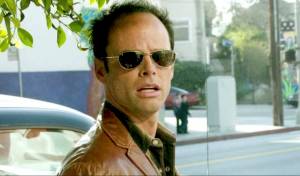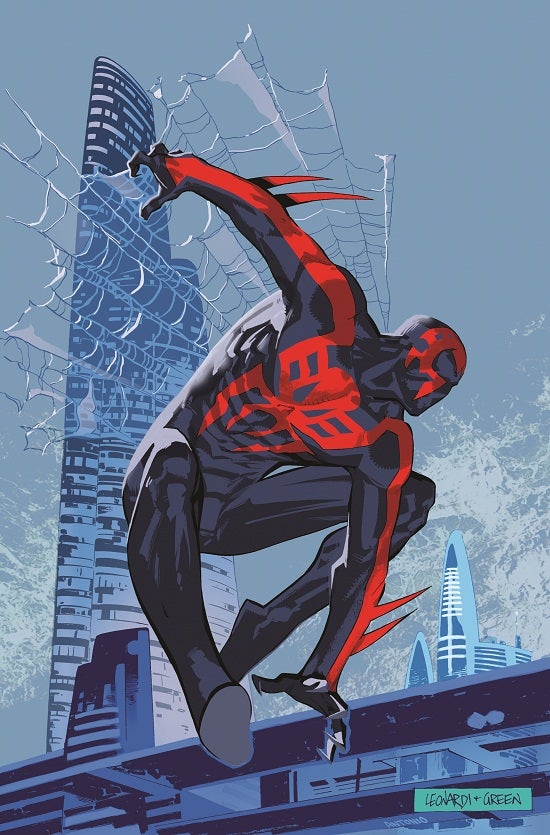
Ever since Dan Slott reintroduced Miguel O’Hara, aka Spider-Man 2099 into the present day Marvel Universe last year in Superior Spider-Man, the character’s original creator, Peter David, has repetitively mentioned how much he enjoyed his time on the original book in the 90s and that he would love to write more adventures starring his futuristic Spider-Man. Those adventure will pick up this week when the second volume of Spider-Man 2099 hits comic book shops, featuring David on scripts and Will Sliney on art.
Videos by ComicBook.com
The first Spider-Man 2099 series launched in 1992 with David on script, Rick Leonardi on pencils and Al Williamson on inks. The issue was one of four “reimagined” Marvel heroes that were the foundation of the company’s 2099 universe – a dystopian world filled with mega-corporations and cyberpunk gangs. Spider-Man 2099’s first issue was immensely successful, and is believed to be the highest-selling Peter David comic ever. The series continued to sell 100,000 copies an issue throughout its 46-issue run, but the concept fell apart when series editor Joey Cavalieri was fired by Marvel in 1996 and David resigned in solidarity. Spider-Man 2099 published two more issues without David, before being cancelled.
In order to whet your appetite for this week’s offering from David and Sliney, this list will take you back to the future. Here’s a sampling of 10 of the very best moments and storylines from the original Spider-Man 2099 series – guaranteed to bring a “shocking” smile to the faces of those who remember this grossly underrated book.
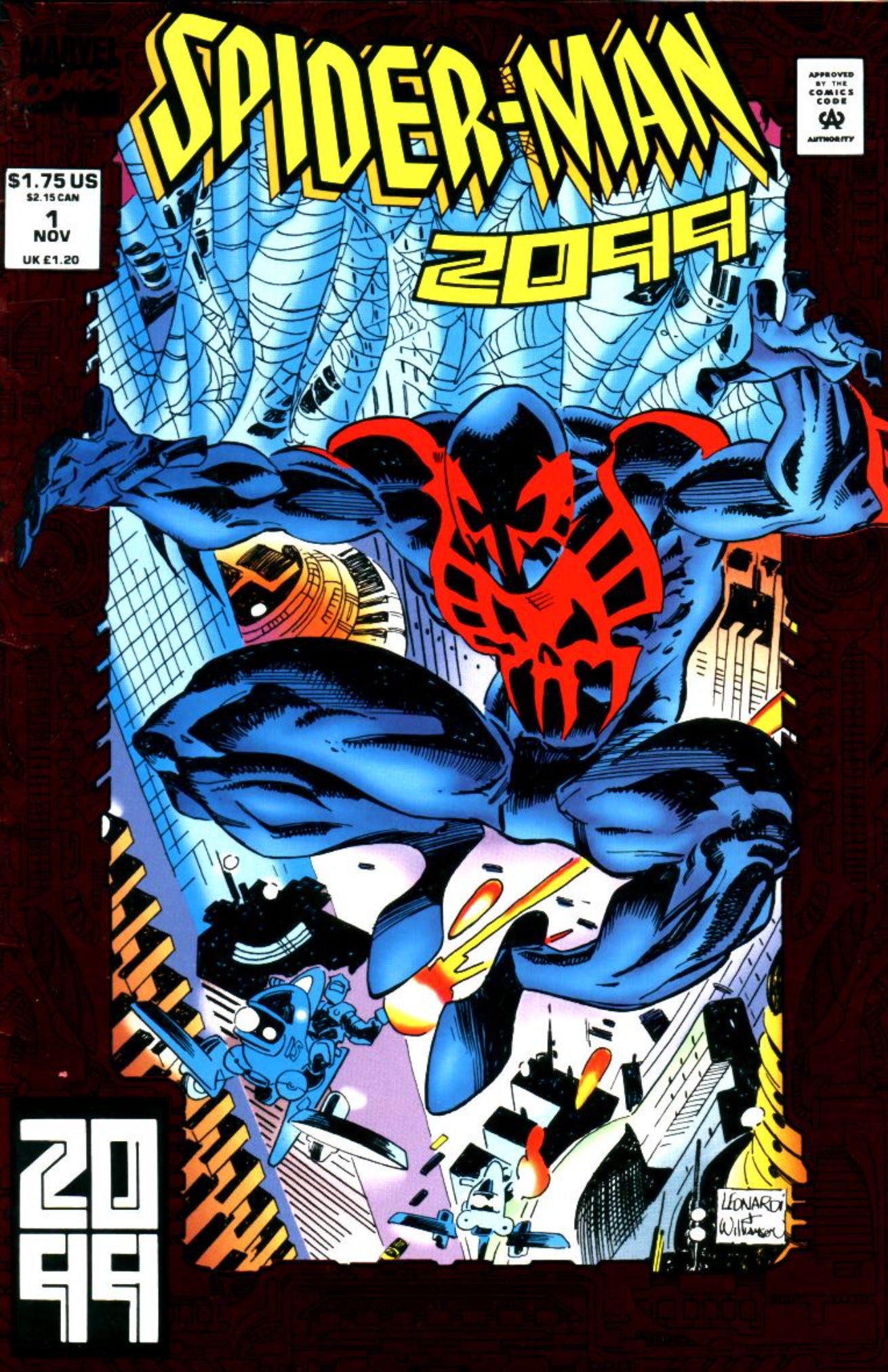
10. Issue No. 1
Spider-Man 2099 #1 is about as good as it gets in terms of a debut issue of a comic book. From the opening splash page, David and Leonardi demonstrate that the “future” of Marvel isn’t just the comic book equivalent of the Jetsons, nor is Spider-Man 2099 going to be another rehash of Peter Parker and his universe.
Instead, the issue is pure world building. There’s a unique cast of characters, which include the hero, Miguel O’Hara, his brother Gabe, and the chief antagonist Tyler Stone, head of the mega-corporation Alchemax. David also has some fun with how he uses language (“shock” is the four-letter word of choice in 2099). To top it all off, there’s plenty of “futuristic” visuals and ideas like flying cars, and hologram answering services/security systems.
Thematically, Spider-Man 2099’s story is undeniably prescient today. The idea of one or two major corporations having their run of the world feels awfully familiar as does the emphasis on how prescribed/federally sanctioned drugs (in 2099-speak it’s “the Rapture) are more addicting than illegal/recreational ones.
On a final note, Leonardi’s design of Miguel’s costume is a thing of beauty. Visually, Spider-Man 2099 pays homage to the red and blue traditions of Spider-Man while also being definitively bold and daring (and “of the future”). In a long line of Spider-Man costumes, 2099 remains one of the very best.

9. Miguel’s First Battle
In Spider-Man 2099 #3, Miguel has his first significant confrontation with an adversary when he squares off against Venture, a cyborg bounty hunter hired by Alechmax to track down Spider-Man. David and Leonardi craft a battle that is thrilling and humorous, and resolve it in a way that illustrates how Miguel is very different from his web-slinging predecessor Peter.
Venture proves to be as arrogant as his is powerful, throwing everything he can muster at Miguel in his attempt to subdue him. Like Peter, Miguel stands his ground, and thrives in the role of underdog. However, unlike Peter, Miguel is not afraid to play the role of the aggressor. He slashes Venture’s legs with his talons, and ultimately defeats him by using his own staff against, sorting out his circuitry and leaving him smoldering. Venture may only be a cyborg and not a living, sentient being, but it is shocking all the same to see Spider-Man react so assertively and violently towards an opponent.

8. Meeting the New Vulture
During the first six issues of Spider-Man 2099, David and Leonardi keep their storyline focused strictly on original characters and concepts. But at the very end of the sixth issue, Spidey fans are treated to a blast from the past (sorta) when a futuristic version of the classic bad guy, the Vulture, is introduced.
Beyond the namesake and the mechanical wings, the 2099 Vulture is nothing like his geriatric predecessor. Readers learn that future Vulture oversees the “Downtown” area of New York, alongside his gang of thugs known as the Freakers. And if that’s not different enough for old-time readers, the new Vulture is an admitted cannibal, who brags about devouring the corpses of his victims.
During his fight with the Vulture, readers once again see how vastly different Miguel is from Peter. After defeating the villain, Miguel attempts to secure him in a web, but the web breaks and Vulture assumedly falls to his death. O’Hara just shrugs his shoulders at the possible idea that his adversary died – an action Peter would have surely felt guilty about.
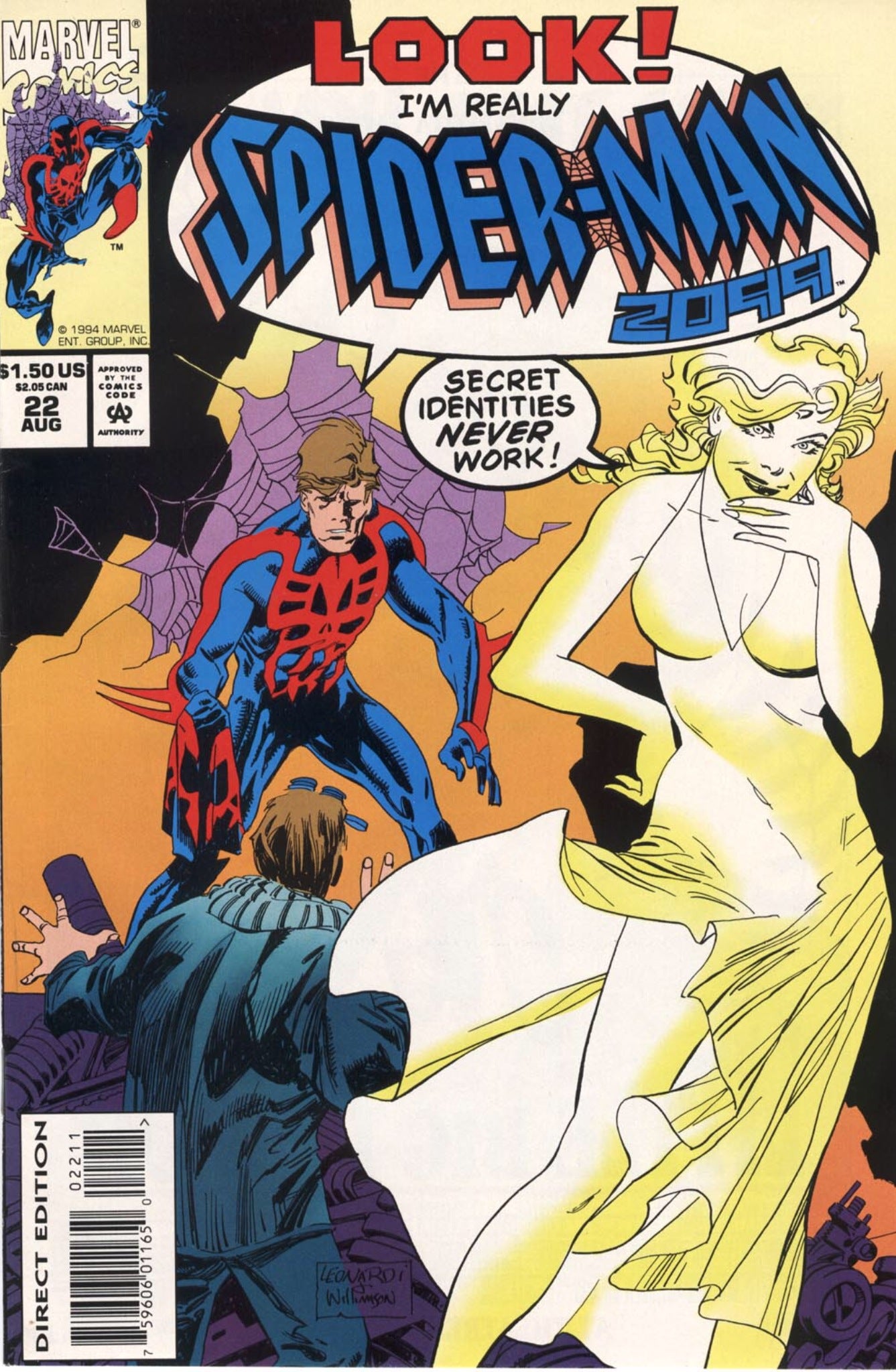
7. Lyla the Hologram
When Lyla,Miguel’s Marilyn Monroe-esque hologram security guard/answering service, is introduced in the very first issue of Spider-Man 2099, it wasn’t initially clear that she was going to be anything other than a device deployed by the creators that demonstrated “futuristic” technology. Instead, David went ahead and gave the hologram a personality. Throughout the run, she continually gets some of the best lines and ultimately functions as Spider-Man 2099’s comic relief.
The character really starts to shine about a dozen issues into the series, when David works in a subplot where there’s something wrong with Lyla’s circuitry and she starts to become unhinged. She becomes insanely jealous of Miguel’s fiancé Dana, and at one point, becomes quite aggressive in offering his brother Gabe a cruller – so much so that it is totally understandable if the reader’s first impulse is to eat one of those fluffy and delicious treats upon finishing that issue for fear of Lyla’s wrath.

6. Meet the Parents
While Peter Parker had the doting love of his Aunt May to support him, his future counterpart Miguel wasn’t so lucky. In Spider-Man 2099 #10, the creative team takes a break from the fast-paced action of the first nine issues and instead crafts a very character-driven story focused on Miguel’s mother Conchata and his deceased father George.
In her very first appearance, Conchata proves to be totally manipulative. She lures her two sons to her bedside where she has fallen “gravely ill” and proceeds to fake her death once everyone arrives. When Miguel calls her out on her nonsense, telling her he’s tired of playing these games “every few months,” Conchata casually gets up and walks out of bed. The character would play an ongoing role in the series, and eventually gets herself into some serious trouble when she attempts to assassinate Tyler Stone in a later issue.
Miguel’s relationship with his father is even more troubling. George is verbally abusive to Miguel and in one flashback challenges his son to hit him back. Miguel refuses, but later admits to himself that he’s glad he didn’t strike his dad because he probably would have ended up killing him.
Spider-Man 2099 #10 would go on to be an integral story in Miguel’s journey, as he ends the issue with the understanding that becoming Spider-Man has changed his view on things. Namely, he realizes that the abuse he once received from his parents doesn’t torment him anymore, because being Spider-Man has given him a sense of resolve and purpose.
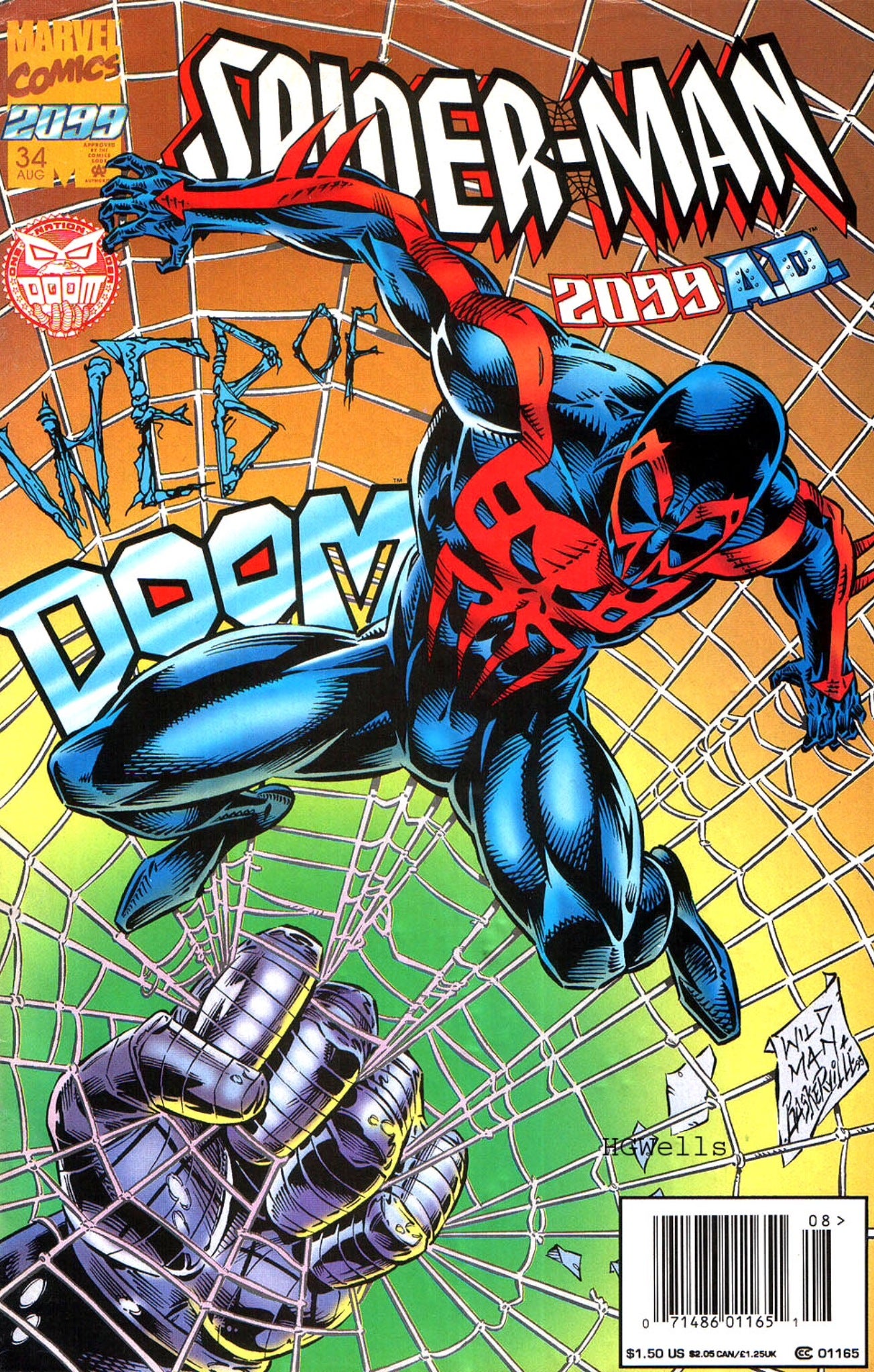
5. The Integration of the 2099 Universe
When Spider-Man 2099 launched in 1992, it was one of four Marvel books set in this future universe alongside Punisher 2099, Doom 2099 and Ravage 2099. As time went on, more 2099 series were introduced including X-Men 2099, Fantastic Four 2099, Hulk 2099 and Ghost Rider 2099. There were also 2099 versions of other mainstay Marvel heroes who were not featured in their own series like Thor and Strange (sans “Doctor”).
With all of these superpowered characters roaming around this universe, it was inevitable for there to be some kind of crossover story. Fortunately, in Spider-Man 2099, these crossovers were integrated effectively and sparingly, and rarely disrupted the overall narrative flow of the book. Going back to the early issues, readers kept hearing about the “Thorites” who worshipped Thor, but it wasn’t until 15 issues in that there was the “Rise of the Hammer” crossover, which integrated all of the 2099 titles being published at the time to tell the story of the future version of the Norse god.
Another crossover is introduced about 20 issues later when Doom takes over the United States and installs himself as president. With Tyler Stone assisting Doom, Miguel is offered an opportunity to assume Tyler’s old position at the research and development department at Alchemax. Installing Miguel at Alchemax offers David a clean way to reset the status quo of his 2099 universe without completely destroying and/or ignoring all the events that came before it. “President Doom” meanwhile is actually a fairly subdued subplot that ends up being a lot of fun to read about since it isn’t the standard “evil genius takes over the world” storyline.

4. The Miguel/Dana/Xina Love Triangle
Taking note from the Stan Lee/John Romita Sr.-era of Peter having to choose between Gwen Stacy and Mary Jane Watson, Peter David incorporates a slow burn love triangle in Spider-Man 2099 that has an incredibly emotional and tragic payoff towards the final issues of the series.
When the series opens up, Miguel is unequivocally with Dana, who the reader later learns was actually once romantically involved with Miguel’s brother Gabe. Concurrently, about a half dozen issues into the series, David began scripting a number of flashback “B” stories, where the reader is introduced to Miguel’s high school sweetheart, Xina Chang. Miguel and Xina first fall for each other when Miguel is nearly killed by Tyler Stone’s son Kron, and the two need to band together to help get him expelled.
Everything comes full circle when presdent-day Miguel turns to Xina to help repair his hologram system, Lyla. It is revealed that Miguel cheated on Xina with Dana. As Xina reluctantly agrees to repair Lyla, she reconnects with Miguel, which naturally leads to Dana being jealous.
As the two women compete for Miguel, the 2099 version of Venom is introduced. By the end of that arc, Dana sacrifices herself for Xina and is killed by Venom. This heartbreaking moment redeems Dana while sending Xina into her own shame spiral.
What makes this storyline so effective is how David’s script plays all sides of the love triangle perfectly. Rather than asking us to pick sides, when it’s all over, the reader naturally likes and identifies with all of the characters involved.
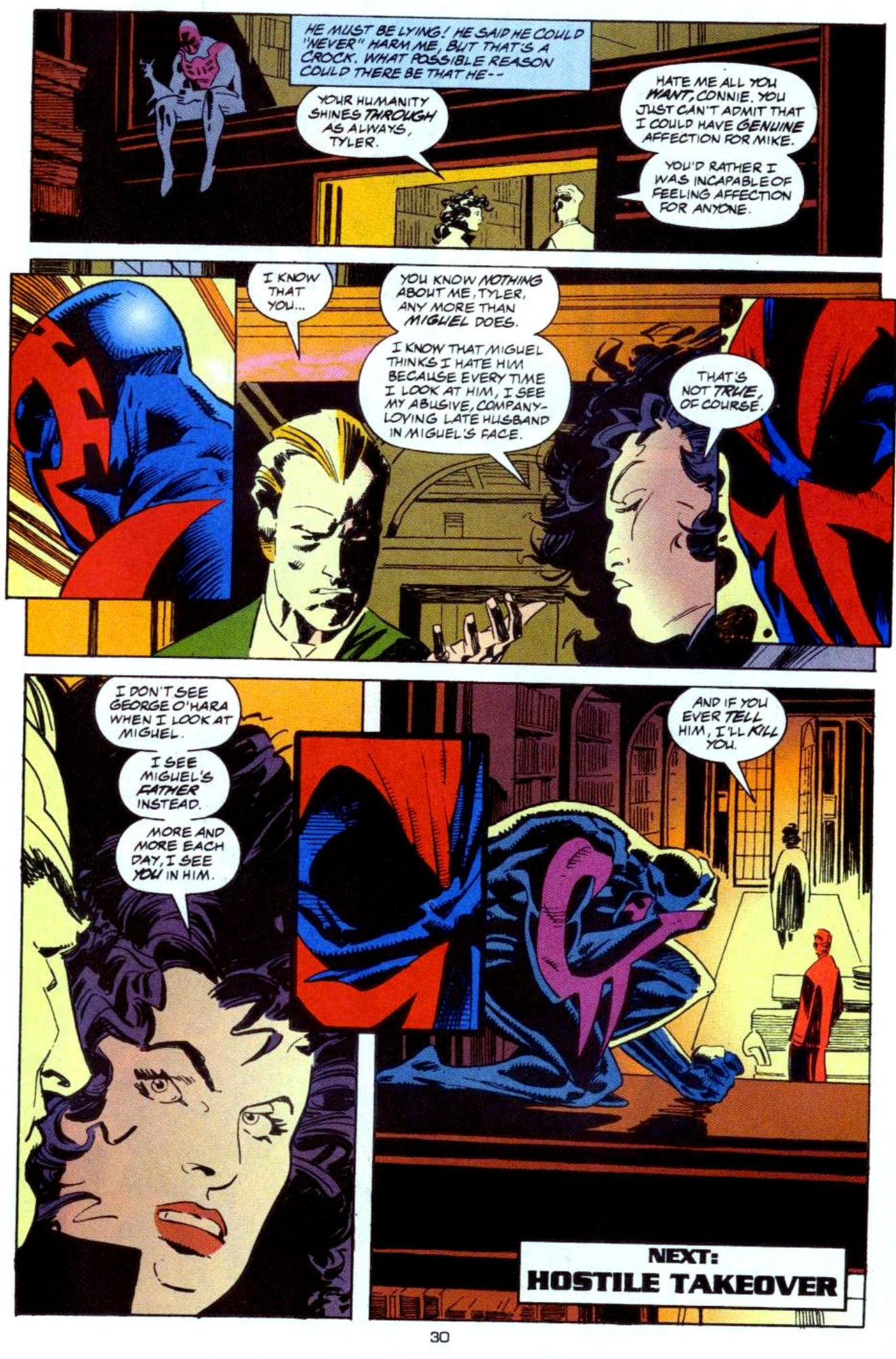
3. Miguel I Am Your Father
Taking a page from the Empire Strikes Back, the special giant-sized 25th issue of Spider-Man 2099 features a startling – yet completely logical – reveal that Tyler Stone, the head of Alechmax and the primary antagonist of the series, is actually Miguel’s father.
The revelation sets off a series of “a ha” moments for the reader. Now everything makes sense about Miguel’s relationships – why his non-biological father appears to resent him, why his mother has this weird fascination with him, why Gabe envies him, and why Tyler’s son Kron seesd so hell bent on killing him when they were all kids in school.
Meanwhile, for Miguel, his relationship to Tyler is the equivalent of Peter finding out he’s actually Norman Osborn’s son. Tyler is everything Miguel hates about the new world order of the 2099 universe, and yet at the same time, the two are inextricably linked. For example, Miguel has a very Tyler-esque response when his father attempts to come clean about their relationship. At this point, Miguel has supplanted Tyler at Alchemax and the only response he can muster is “I know,” before he throws his father out of his office.

2. Venom 2099
As Spider-Man 2099 rolls into its third year of publication, the series inevitably loses some steam. A rotating batch of artists, including Ron Lim, take over for Leonardi, which disrupts the visual flow of the book. Meanwhile, the overall narrative starts to become a bit repetitive as there’s only so much of Miguel fighting Freakers and corporate stooges over and over before the series needs a kick in the pants.
Enter Venom 2099.
At this point, everyone’s favorite fang-mouthed, brain-eating alien symbiote had become overexposed in the comic book marketplace. But there is something about the way David weaves Venom into the 2099 universe that makes the character seem fresh and exciting again. For one, it is patently obvious that whoever is bonded to the symbitoe has a very personal issue with both Spider-Man and Miguel, which unquestionably fuels the arc’s tension (it turns out to be Kron Stone, Tyler’s son). Beyond that, David tones down the camp of the character, and instead plays up Venom’s menace. The Venom arc is one of the few times since the opening batch of issues where Miguel is an underdog. And while he scores a victory against Venom, it turns out to be pyrrhic when his fiancé Dana is killed.
Readers who stuck around 2099 for this arc were treated to one of the better Venom stories since the character was first introduced by David Michelinie and Todd McFarlane in the late 1980s in the “mainstream” Amazing Spider-Man series.

1. Spider-Man Meets Spider-Man 2099
While this moment didn’t technically take place in Spider-Man 2099’s original run of 46 issues, it was published concurrently with the series, and is probably one of the better Spider-Man stories to be released during the character’s mid-90s doldrums.
David and Leonardi work together once again for this special, double-sized one-shot, which continuity-wise was released immediately before Spectacular Spider-Man #226 (aka, the issue where it is revealed that Peter is a clone and Ben Reilly is the original Spider-Man). Fortunately, the word “clone” is nowhere to be found in this comic.
Instead, readers are treated to an incredibly fun script where Miguel and Peter accidentally switch places in the timestream and need find their way back. Miguel has the honor of waking up in the present day next to Peter’s wife Mary Jane (who is shocked, but not THAT shocked by the whole thing), while Peter is placed in the exact opening moment of Spider-Man 2099 #1 – a wonderful visual homage courtesy of Leonardi.
As an added treat, the comic also introduces readers to another future Spidey, Spider-Man 2211 (who will likely make an appearance in this Fall’s Spider-Verse event).
Peter and Miguel eventually make their way back to their respective present days, but not before sharing some philosophical insights in passing. Peter asks Miguel “why he does it” (be Spider-Man), and his response is “because I have to.” Peter acknowledges that he too, is Spider-Man out of obligation, giving credence to the fact that “with great power, must also come great responsibility,” does survive into the year 2099.




